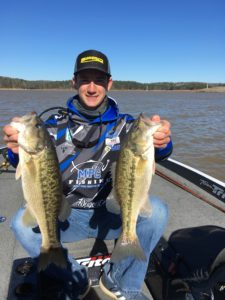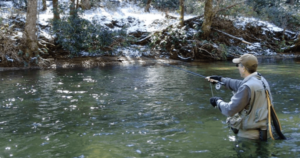White Bass Time Across Arkansas
Randy Zellers Assistant Chief of Communications
Arkansas Game and Fish Commission
from the Fishing Wire
LITTLE ROCK — Each spring, anglers across The Natural State start getting the fever for some fishing action. Sure, die-hard anglers and veteran bass fishermen have been on the water fishing for big fish for the last month or so, and many crappie anglers never put the boat away in winter, but by and large, the best angling action of the year is just around the corner. If there’s a kickoff to “fishing season,” it’s the fast and furious angling action brought on by the annual migration of white bass from large lakes and rivers upstream to their spawning areas each spring.
“The white bass spawn is fishing’s equivalent of the opening day of dove season,” said Chris Racey, deputy director of the Arkansas Game and Fish Commission. “You’ll start hearing people ask, ‘Are the white bass running yet?’ beginning in late February and early March every year.”
White bass typically start concentrating near the mouths of streams feeding lakes and rivers each year as the surface water temperature begins to reach 50 degrees. When the water warms to the mid-50s, the fish will move upstream as far as they are able and spawn on sand or gravel surfaces with flowing water that will aerate their eggs.
“White bass don’t tend and fan a nest like crappie, bream or largemouth bass,” Racey, who was a fisheries biologist for the AGFC for many years, said. “Instead, their eggs settle to the bottom and stick to rocks and gravel where the current keeps them aerated until they hatch.”
The fish actually don’t bite much when they are actively spawning, but feed heavily just before and afterward.
“It’s more a matter of fish being concentrated in an area and being easier to locate that makes the white bass run such a big deal for many anglers,” Racey said. “And this is one of the few times of the year that these fish, which normally spend their time in deep water, will be available for bank anglers.”
Keeping things light is a must for walk-in angling, and Racey has narrowed down his arsenal to some specific lures for people to carry in their pack.
“I have three baits in my white bass tackle box,” Racey said. “My go-to is a white 2-inch curly shad Bass Assassin grub on a 1/16-oz. jighead. Then I’ll bring a ?- or ¼-oz. White spinner with a silver blade and a small, blue over orange belly Rapala suspending jerk bait. You can throw all of them on light spinning tackle.”
Here’s a list of some of the most popular places to try your hand at fishing for white bass this spring, according to the biologists who work and fish on these waters. There’s even one location in this list that has no limit on white bass, so anglers looking to have a family fish fry can load the boat.
Magical Millwood
Typically one of the first locations in the state to start receiving reports about the annual white bass run is Millwood Lake in Little River County. This southwestern Arkansas reservoir is known as one of the best places in the state to chase memorable-sized largemouth bass because of an intense Florida-strain largemouth stocking program that has been in place for decades and its shallow-water habitat that is the key to the strain’s success. The river that feeds this giant reservoir also is home to some incredible action during the white bass spawn if anglers know where to look. According to AGFC Regional Fisheries Biologist Supervisor Eric Brinkman, many anglers enjoy fishing the river section of the lake by boat for fiesty white bass.
“Little River anywhere upstream of Yarborough Landing on Millwood is a good place to fish,” Brinkman said.
According to the AGFC Weekly Fishing Report, Millwood Lake Guide Service points out McGuire Oxbow and the entrance to Cemetery Slough as likely staging areas, but when the fish move upstream of the U.S. Highway 71 bridge, the spawn is in full force.
Other areas on Brinkman’s short list for the white bass spawn include Star of the West Recreation Area and Self Creek on Lake Greeson in Pike County and the Saline River upstream of Dierks Lake in Sevier County, although a boat is required for Self Creek and Dierks.
Bust ‘em at Beaver Lake
In the far northwestern corner of the state, Beaver Lake offers one of the best white bass runs for Arkansans. It also has the distinction of being one of the few places in the state where you may find a trophy-class striper working its way up the same tributaries as the white bass. Fisheries Supervisor Jon Stein says this year has already gotten off to an excellent start, with many anglers reporting 100-fish days. And keeping those white bass is no issue because Beaver Lake and its tributaries have no daily limit for white bass. The prolific nature of the species and relatively light pressure on the resource have made limits on the fish unnecessary in this corner of the state.
“The fish move into the river arms to spawn,” Stein said. “The best locations are out of the Highway 45 Access, called Twin Bridges, on the White River and War Eagle Creek below War Eagle Mill. You don’t have to get too technical with it, either. A Mister Twister Sassy Shad on a jighead works just fine for me to catch whites on the run.”
Find the flow at Lake Conway
White bass also make a spawning run around Lake Conway, but the hot bite may be in different locations depending on water flow. AGFC Regional Fisheries Supervisor Tom Bly and Fisheries Biologist Matt Schroeder both agree that the upstream end of Gold Creek beyond Wilhelmena Cove, a popular crappie-fishing location, in the northwest portion of the lake has a good run of white bass. Another place where anglers can look for some action is below the dam where the lake flows into Palarm Creek.
“We will get reports of white bass and some stripers from the Arkansas River running up to as far as the Conway Dam, but there won’t be much action unless the gates of the dam are open to maintain water levels during rain events,” Bly said. But you can catch them on white or shad-colored curly tailed grubs on jigheads, smaller crankbaits or shad imitations on a fly rod.”
Bly notes the weir on Palarm Creek at Cadron Settlement Park on the Arkansas River sees a similar migration of white bass where the fish moving from the river are concentrated into a small area.
Greers Ferry a good bet
Another good white bass run occurs in the river arms on the northern section of Greers Ferry Lake in Heber Springs. The lake is known as the site of the former world-record walleye, and that species also is known to make spawning runs within the Devil’s Fork, Middle Fork and South Fork of the Little Red River. Chasing white bass on this lake usually means having a boat, but one of the most popular destinations can be found at the Johnson Hole Access of the South Fork arm north of Clinton. Boaters can access the area from the lake or can launch at this access, but the creek has many shallow areas between the main lake and where the whites run, making it a better prospect for small boats, kayaks and walk-in access. According to Bly, many anglers will catch their limits in this section of the river during the annual spawning run.
Maumelle mainstay
It seems like every year, one location sees more attention than the rest in the state from white bass anglers. Perhaps it is because of its close proximity to Little Rock, or perhaps it is because the white bass run here is just that good. Either way, the upstream end of Lake Maumelle is so popular with white bass anglers and creek fishermen that the AGFC and Central Arkansas Water worked together to enhance access at the west end of the lake. Sleepy Hollow Access was enhanced with a campground, two boat ramps for boats with motors 25 horsepower and less and a courtesy dock. A parking area also was constructed for a special walk-in only area called Bringle Creek Access. Both of these access points can be found with a few miles of where Arkansas Highway 10 crosses the lake’s upstream end. You’d be hard pressed to find either of the parking lots of these areas empty from March through May each year as anglers tote their favorite spinning rod and curly-tailed grubs to fool the fish as they feed along the shoals before spawning. The stream is part of Lake Maumelle, so no wading is allowed, but there is plenty of shoreline to walk and fish.


